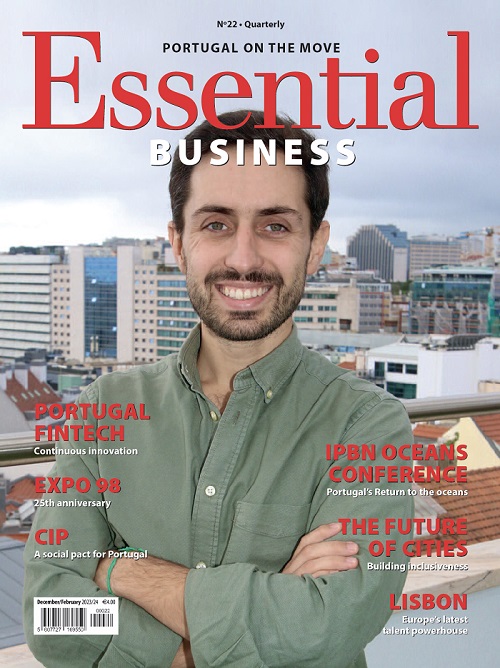Offices – Why demand for Grade A ESG standard offices remains strong
Since Acacia Point Capital Advisors took over the management of Quinta da Fonte office park in Oeiras in 2018, the asset has enjoyed significant investment and improvement. Essential talks to Matthew Walker, Acacia’s Europe managing director.
Text: Chris Graeme
Quinta da Fonte, the pioneering modern office park in Portugal, was an innovation and revelation when it was launched in 1993. However, between 2010 and 2018, the office park had changed little and was in need of rebranding, refurbishing and major improvements. That attention and investment came in 2018, when Acacia Point took over the management of the asset.
“Between 2010 and 2018, QdF had been neglected. It suffered from fragmented ownership, traffic and parking chaos, poor management, no unified strategy and ‘absent’ owners unwilling to maintain or invest in their buildings. The park was at its lowest ebb and it was a great shame to observe the decline of what was once Portugal’s premier business park,” says Matthew Walker.
“However, it was our view that, despite its problems, fundamentally QdF was a fantastic piece of real estate. We had a deep belief that its fortunes could be resurrected if we progressively acquired the buildings from its disparate owners, then applied best-in-class asset management, invested in the buildings, landscaping and infrastructure, and reconnected with the tenants. We started acquiring buildings in 2018, and over the following two years, we purchased 15 buildings and one plot of development land from six separate sellers,” he explains.
Once Acacia had ownership control, it made transformational changes, including:
Articulated plans with other building owners at QdF and garnered their support to upgrade the park.
Sought feedback via a survey of the companies and employees at QdF, to better understand their needs, which enabled them to firstly focus on the most important upgrades to create greatest satisfaction.
Refurbishing the buildings and upgrading their mechanical and electrical infrastructure, with a focus on environmental sustainability.
Investing heavily in the landscaping and leisure areas across the 12-hectare estate, which are a natural feature of the quinta, yet had been neglected.
Creating more restaurants, services and leisure facilities to better serve the 6,000 people that work at QdF. Today there are eight restaurants/cafes, ad hoc food vans, a Holmes Place gym, a para-pharmacy, a hairdresser, a nail/beauty salon, and a printing/copy shop.
Actively engaging with client tenants and the personnel that work at QdF and implementing an events calendar to create a strong sense of community and togetherness. Some 2,000 people from QdF attended the 30th anniversary celebration event hosted recently, which was a roaring success.
Eliminating the former parking and traffic problems that plagued QdF. Accessing the A5 highway from QdF now takes only minutes, and today there’s ample available parking for any employee or visitor – a great relief for all.
Matthew Walker says QdF’s transformation has been achieved by setting an ambitious strategy, being bold and willing to make significant financial investments into the refurbishment programme, and by having a highly competent and dedicated on-site management team. Acacia Point has 7 people stationed at QdF.
Matthew adds that both he and Luís Rocha Antunues, partner and managing director at Acacia Point Capital Advisors (Portugal), have a personal investment in the ownership of QdF. “We have extraordinary passion and a ‘whatever it takes’ philosophy to deliver the very best outcome for QdF, our tenant community, their employees and our co-investors.”
The implications of ESG
Matthew Walker agrees that there is demand for quality, modern offices with today’s energy, water-saving and sustainable features in the Greater Lisbon Metropolitan Area.
“The integration of sustainability into an investor’s real estate strategy has become critical. One of the first questions we are asked by global companies when they come to QdF is ‘what is your ESG strategy’. ESG [referring to ‘Environmental, Social and Governance’ factors] is also a leading question from banks when financing real estate acquisitions and is a core consideration of institutional investors across the globe,” he says.
And adds: “We have devised an extensive (and deliverable) ESG policy for our buildings at QdF and are well advanced with pursuing ‘BREEAM Excellent’ accreditation, which is a badge of assurance regarding a building’s quality, performance and sustainable credentials. The certification process is very rigorous, can take more than one year to obtain and requires extensive building refurbishment to achieve the desirable ‘Excellent’ ranking.”
Matthew points out that the good news for landlords is that the fulfilment of an ESG strategy “requires no rocket science”. However, the ongoing investment of time, resources and costs are vast when retrofitting existing buildings to meet and maintain ESG compliance, and that is proving to be a high barrier for many building owners. As occupiers, lenders and investors become even more assertive on their ESG requirements, the market, he says, will progressively polarise into the distinct categories of those buildings/landlords that are ‘genuinely’ delivering on ESG and those that are floundering or not bothering. The economic implications of this ESG phenomenon on property owners will be immense.
“We are now harvesting results from being genuinely committed and delivering on an ESG policy. QdF is attracting and retaining the world’s leading tech, pharma, engineering and financial services companies and rents are now €17/sqm/month, up from €6 to €9/sqm/month when we started to acquire the buildings back in 2018. Further, our ESG commitments enabled us to access fantastic debt refinancing terms last year, and our portfolio at QdF will be highly attractive to any ESG-focused investor in the future, thus underwriting its value.”
Hybrid office models
Since Covid-19, some companies have opted for a more flexible, hybrid approach regarding their employees, allowing them to work from home on some days of the week. However, that is not the case for all companies.
As Matthew explains: “Our regular interaction with the CEOs and CFOs of companies that occupy space at QdF indicates that companies prefer their staff to spend the majority of their time back in the office. The overriding feedback is that returning to the office generates greater collaboration, teamwork, community, creative interaction, and better mentoring/training of new personnel. The office also provides employees with full access to elaborate technology and ergonomic workplace furniture and gives companies greater confidence in data security and, in some instances, employee productivity.
“Clearly, there are differences between business sectors in terms of how they embrace hybrid working models. For example, tech companies tend to be more flexible: many had already embraced hybrid work models pre-Covid,” he says.
Matthew points out that, to attract personnel back to the office, Acacia is seeing companies give greater consideration to the building they occupy and its internal design of space. Talent retention can be improved by providing an appealing work environment within a modern office with green/sustainable features, more casual lounge collaboration areas (not just formal conference rooms), hotel-quality bright bathrooms, and a focus on better hospitality (for example upmarket, well-provisioned breakout/lunch areas interfacing with an outdoor garden or rooftop spaces, improved coffee/snacks, and so on).
Flexibility on daily start/finish times and hybrid working is, he adds, ingrained long term, as there is an appreciation that it can improve staff satisfaction and attract talent in a tight labour market. “If we look forward 12-24 months, I can foresee that the majority of employees will spend circa four days a week in the office (plus ad-hoc flexibility), with tech and a selection of other business sectors providing more flexibility where it’s deemed to be mutually beneficial. Those companies most successful in attracting employees back to the office with least friction will have rebooted their culture, embraced sustainability and technology and adapted their workspace to make it more attractive.
“Consequently, we are observing companies expand their office space requirements, redesigning and modernising their internal fit-out and focusing on the most appealing ‘Grade-A’ buildings, such as QdF with strong environmental sustainability credentials. So, the investment outlook for high-quality and well-managed office buildings remains strong.
Conversely, lesser quality office buildings that have not been renovated and are poorly managed will lose tenants, suffer from higher vacancy, and be more difficult to refinance or sell,” Matthew explains.
However, Matthew concludes that in other countries there will be different dynamics that influence the outcome of returning to the office. In London, for example, where commute times can be severe and often via expensive, overcrowded and unreliable public transport in adverse weather conditions, it may prove more complex for companies to attract staff back to the office. “There’s no one-size-fits-all format when it comes to the post-Covid workplace.”










